Question
Exceptions This assignment is not as complicated as it might seem. Just proceed step-by-step through Part-A, Part-B and Part-C. *Needed Files* AccountTest.java : /** This
Exceptions
This assignment is not as complicated as it might seem. Just proceed step-by-step through Part-A, Part-B and Part-C.
*Needed Files*
AccountTest.java :
/**
This program demonstrates how the BankAccount
class constructor throws custom exceptions.
*/
public class AccountTest
{
public static void main(String [] args)
{
// Force a NegativeStartingBalance exception.
try
{
BankAccount account =
/ew BankAccount(-100.0);
new BankAccount("-101.0");
System.out.println("Bank account has been created");
}
catch(NegativeStartingBalance e)
{
System.out.println(e.getMessage());
}
}
}
BankAccount.java :
/**
The BankAccount class simulates a bank account.
*/
public class BankAccount
{
private double balance; // Account balance
/**
This constructor sets the starting balance
at 0.0.
*/
public BankAccount()
{
balance = 0.0;
}
/**
This constructor sets the starting balance
to the value passed as an argument.
@param startBalance The starting balance.
@exception NegativeStartingBalance When
startBalance is negative.
*/
public BankAccount(double startBalance)
throws NegativeStartingBalance
{
if (startBalance
throw new NegativeStartingBalance(startBalance);
balance = startBalance;
}
/**
This constructor sets the starting balance
to the value in the String argument.
@param str The starting balance, as a String.
*/
public BankAccount(String str)
throws NegativeStartingBalance
{
this(Double.parseDouble(str));
// double startVal = ;
// BankAccount(startVal);
// throw new NegativeStartingBalance(str);
// balance = Double.parseDouble(str);
}
/**
The deposit method makes a deposit into
the account.
@param amount The amount to add to the
balance field.
*/
public void deposit(double amount)
{
balance += amount;
}
/**
The deposit method makes a deposit into
the account.
@param str The amount to add to the
balance field, as a String.
*/
public void deposit(String str)
{
balance += Double.parseDouble(str);
}
/**
The withdraw method withdraws an amount
from the account.
@param amount The amount to subtract from
the balance field.
*/
public void withdraw(double amount)
{
balance -= amount;
}
/**
The withdraw method withdraws an amount
from the account.
@param str The amount to subtract from
the balance field, as a String.
*/
public void withdraw(String str)
{
balance -= Double.parseDouble(str);
}
/**
The setBalance method sets the account balance.
@param b The value to store in the balance field.
*/
public void setBalance(double b)
{
balance = b;
}
/**
The setBalance method sets the account balance.
@param str The value, as a String, to store in
the balance field.
*/
public void setBalance(String str)
{
balance = Double.parseDouble(str);
}
/**
The getBalance method returns the
account balance.
@return The value in the balance field.
*/
public double getBalance()
{
return balance;
}
}
NegativeStartingBalance.java :
/**
NegativeStartingBalance exceptions are thrown by the
BankAccount class when a negative starting balance is
passed to the constructor.
*/
public class NegativeStartingBalance
extends Exception
{
/**
This constructor uses a generic
error message.
*/
public NegativeStartingBalance()
{
super("Error: Negative starting balance");
}
/**
This constructor specifies the bad starting
balance in the error message.
@param The bad starting balance.
*/
public NegativeStartingBalance(double amount)
{
super("Error: Negative starting balance: " +
amount);
}
}
Payroll.java :
/**
The Payroll class stores data about an employee's pay
for the Payroll Class programming challenge.
*/
public class Payroll
{
private String name; // Employee name
private int idNumber; // ID number
private double payRate; // Hourly pay rate
private double hoursWorked; // Number of hours worked
/**
The constructor initializes an object with the
employee's name and ID number.
@param n The employee's name.
@param i The employee's ID number.
*/
public Payroll(String n, int i)
{
name = n;
idNumber = i;
}
/**
The setName sets the employee's name.
@param n The employee's name.
*/
public void setName(String n)
{
name = n;
}
/**
The setIdNumber sets the employee's ID number.
@param i The employee's ID number.
*/
public void setIdNumber(int i)
{
idNumber = i;
}
/**
The setPayRate sets the employee's pay rate.
@param p The employee's pay rate.
*/
public void setPayRate(double p)
{
payRate = p;
}
/**
The setHoursWorked sets the number of hours worked.
@param h The number of hours worked.
*/
public void setHoursWorked(double h)
{
hoursWorked = h;
}
/**
The getName returns the employee's name.
@return The employee's name.
*/
public String getName()
{
return name;
}
/**
The getIdNumber returns the employee's ID number.
@return The employee's ID number.
*/
public int getIdNumber()
{
return idNumber;
}
/**
The getPayRate returns the employee's pay rate.
@return The employee's pay rate.
*/
public double getPayRate()
{
return payRate;
}
/**
The getHoursWorked returns the hours worked by the
employee.
@return The hours worked.
*/
public double getHoursWorked()
{
return hoursWorked;
}
/**
The getGrossPay returns the employee's gross pay.
@return The employee's gross pay.
*/
public double getGrossPay()
{
return hoursWorked * payRate;
}
}
PayrollDemo.java :
import java.util.Scanner;
/**
This program demonstrates a solution to the
Payroll Class programming challenge.
*/
public class PayrollDemo
{
public static void main(String[] args)
{
// Variables for input
String name; // An employee's name
int id; // An employee's ID number
double payRate; // An employee's pay rate
double hoursWorked; // The number of hours worked
// Create a Scanner object for keyboard input.
Scanner keyboard = new Scanner(System.in);
// Get the employee's name.
System.out.print("Enter the employee's name: ");
name = keyboard.nextLine();
// Get the employee's ID number.
System.out.print("Enter the employee's ID number: ");
id = keyboard.nextInt();
// Get the employee's pay rate.
System.out.print("Enter the employee's hourly pay rate: ");
payRate = keyboard.nextDouble();
// Get the number of hours worked by the employee.
System.out.print("Enter the number of hours worked " +
" by the employee: ");
hoursWorked = keyboard.nextDouble();
// Create a Payroll object and store the data in it.
Payroll worker = new Payroll(name, id);
worker.setPayRate(payRate);
worker.setHoursWorked(hoursWorked);
// Display the employee's payroll data.
System.out.println(" Employee Payroll Data");
System.out.println("Name: " + worker.getName());
System.out.println("ID Number: " + worker.getIdNumber());
System.out.println("Hourly pay rate: " + worker.getPayRate());
System.out.println("Hours worked: " + worker.getHoursWorked());
System.out.println("Gross pay: $" + worker.getGrossPay());
}
}
Pages 730-733 :
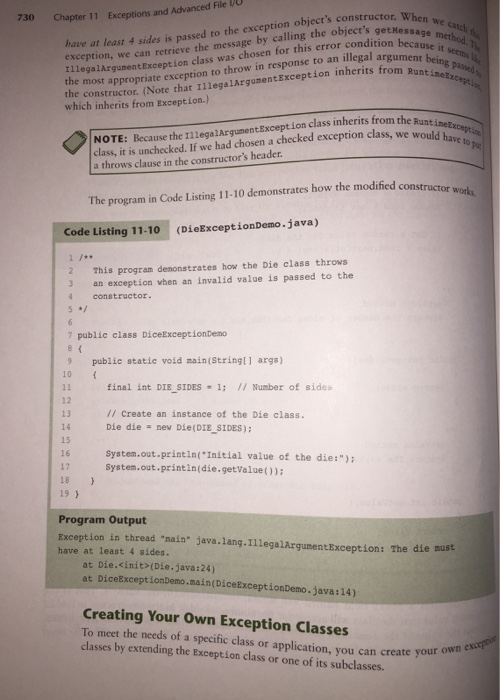
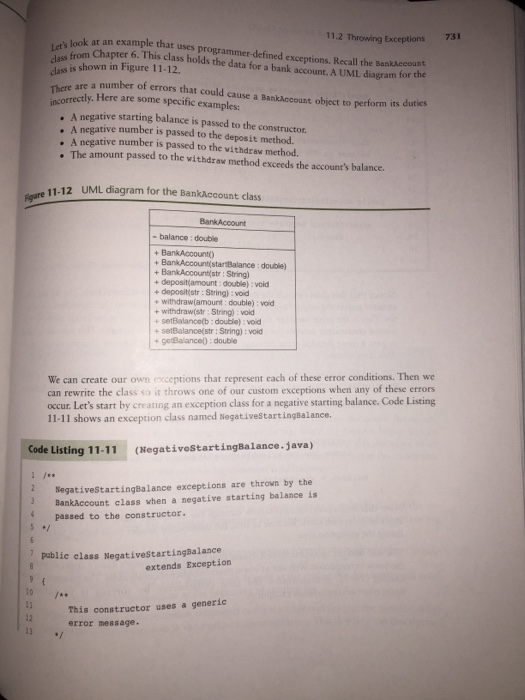
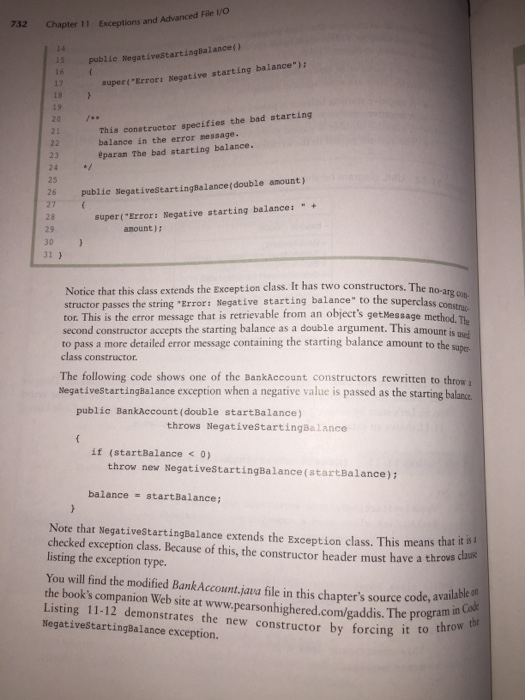
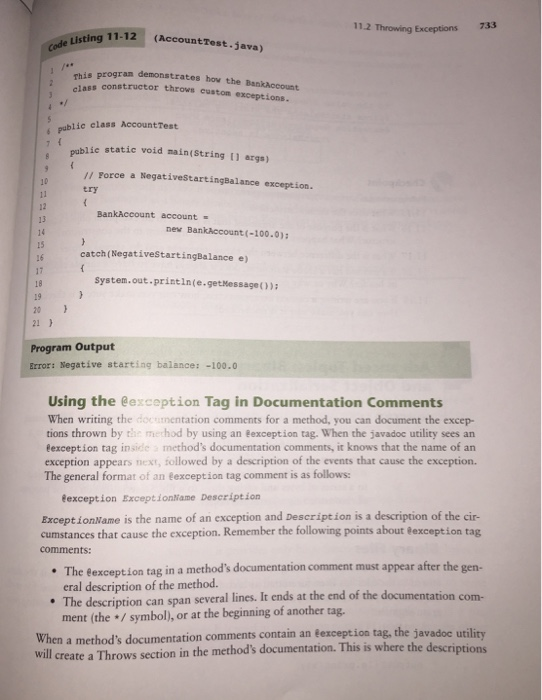
Page 397(Payroll class):
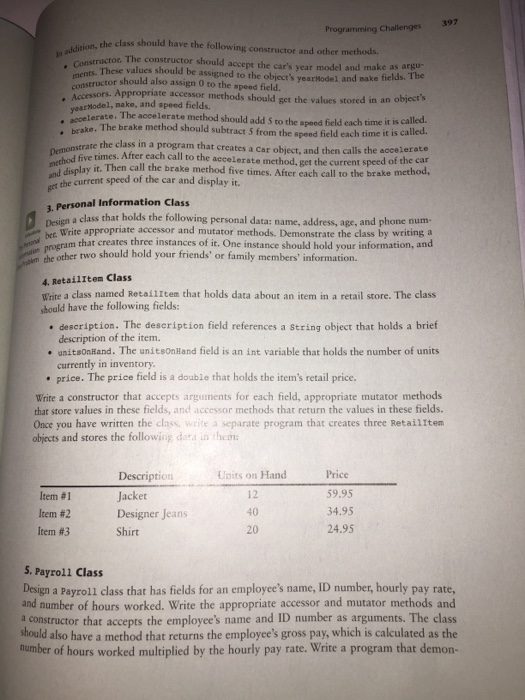
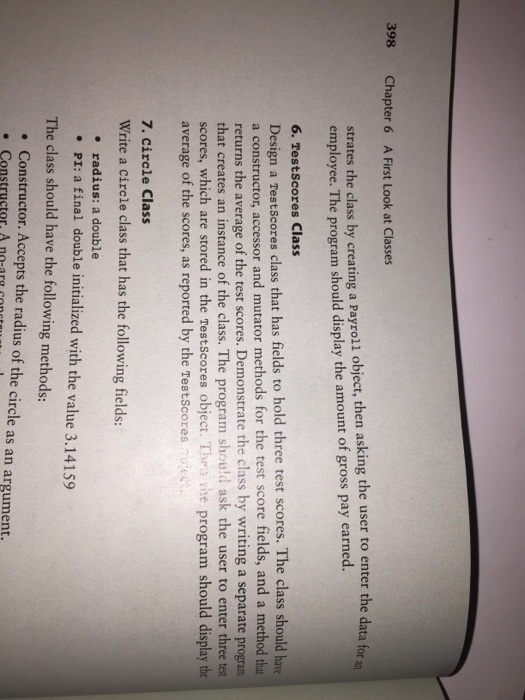
Page 758:
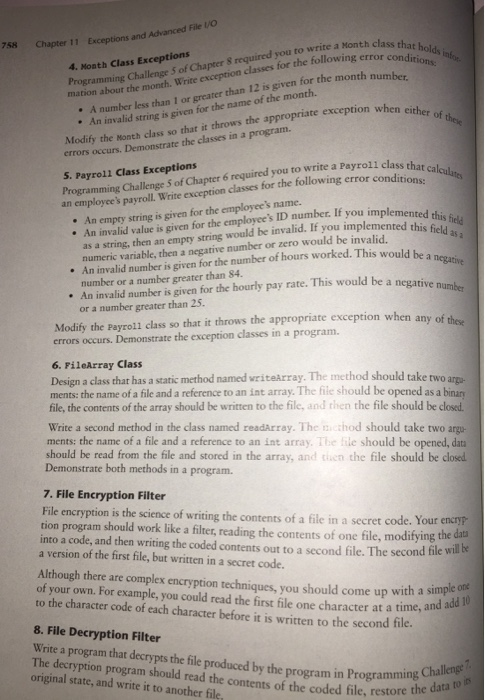
Part-A
Set up and run the code for the topic Creating Your Own Exception Classes on pages 730-733. You will need some source files from Source Code Listings provided for you on Distributed Documents.
Set up a java folder containing:
AccountTest.java
BankAccount.java
NegativeStartingBalance.java.
Compile the 3 files
Run AccountTest.
This provides a sample of how to handle exceptions under program control instead of just letting the program crash. This will be a guide for doing Part-C below.
Part-B
You are provided with the textbook solution to Programming Challenge-5: Payroll Class on page 397.
Set this up to run as described in chapter-5 page 397. Errors lead to program crashes showing a call-back sequence to help you find your errors and have a chance at fixing them.
Part-C
Use the classes from Part-B above to complete Programming Challenge #5 on page 758. Use the ideas and methodology from Part-A to aid you in constructing and using custom exception classes for this assignment. The instructions for this are repeated here with small modifications:
Write exception classes for the following 4 error conditions:
An empty string is given for the employees name.
An invalid value is given for the employees identification number. If you implemented this field as a string, then an empty string would be invalid. If you implemented this field as a numeric variable, then a negative number or zero would be invalid.
An invalid number is given for the number of hours worked. This would be a negative number or a number greater than 84. Hours worked may have a decimal fraction.
An invalid number is given for the hourly pay rate. This would be a negative number or a number greater than 25. Pay rate may have a decimal fraction.
Modify the Payroll class from Part-B so that it throws the appropriate exceptions when any one of these 4 exceptions occurs.
You should note that each different exception requires a separate class (so you need 4 exception classes). Also, note that you need to add a throws clause to the heading line of each method that may throw a specific exception. (See how Part-A handles these needs.) Demonstrate the exception classes in a demo program. You will need separate try-catch blocks for each exception that you are handling.
What to hand in:
Demonstrate to your teacher all the working exceptions from Part-C above.
Then submit your program listings in a Zip file.
File U0 have at least 4 sides is passed to the exception object's constructor. When exception, we can retrieve the message by calling the objecr's getHessae we catch 730Chapter 11 Exceptions and Advanced the most appropriate exception to throw in response to an illegal armt seen the constructor. (Note that IllegalArgumentexception inherits fromung which inherits from Exception.) being passed 11legalArgunentException class was chosen for this error condition becaus thod NOTE: Because the 111ega ArgumentExcept ion class inherits from the Runt class, it is unchecked. If we had chosen a checked exception class, we a throws clause in the constructor's header n class, we would have to would have to pu The program in Code Listing 11-10 demonstrates how the modified constructor Code Listing 11-10 (DieExceptionDemo.java) 2This program denonstrates how the Die class throws 3 an exception vhen an invalid value is passed to the 4 constructor 7 public class DiceExcept ionDemo 9 public static void main(String1 args) 10 final int DIESIDES ; // Number of sides - 12 13 14 Die die nev Die(DIE SIDES) 15 16 17 18 19 h // Create an instance of the Die class. system.out.printin( Initial value of the die:") System.out.printin(die.getValue()) Program Output Exception in thread "nain" java.1ang.1llegalArgumentException: The die must have at least 4 sides. at Die.cinit>(Die.java:24) at DiceExceptionDemo.main(DiceExceptionDemo.java:14) Creating Your Own Exception Classes To meet the needs of a specific class or application, you can create your classes by extending the Exception class or one of its subclassesStep by Step Solution
There are 3 Steps involved in it
Step: 1

Get Instant Access to Expert-Tailored Solutions
See step-by-step solutions with expert insights and AI powered tools for academic success
Step: 2

Step: 3

Ace Your Homework with AI
Get the answers you need in no time with our AI-driven, step-by-step assistance
Get Started


